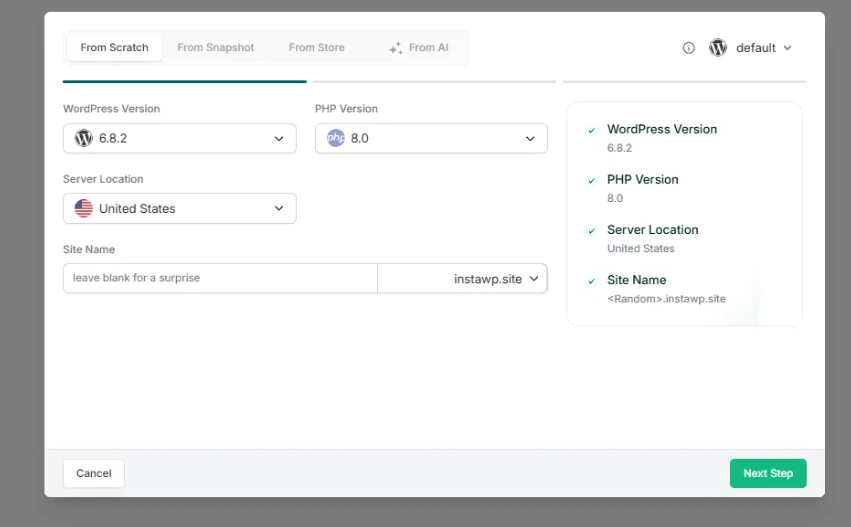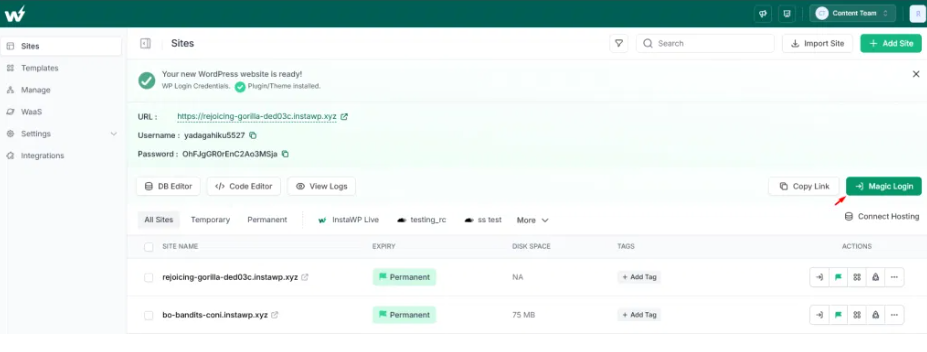In WordPress development, testing directly on a live site is still one of the most common mistakes. According to a 2024 survey by Patchstack, more than 60% of site breakages reported by agencies were caused by untested plugin or theme updates.
The safer path is to adopt a sandbox-first workflow. A WordPress sandbox is an isolated environment where you can install plugins, switch themes, and test workflows without risking production sites.
This post will explore how developers and agencies can carry out WordPress plugin testing and WordPress theme testing in a controlled, disposable WordPress sandbox environment.
What is a WordPress Sandbox?
A WordPress sandbox is a safe, temporary environment where developers can test changes before applying them to a live website. Think of it as a practice ground. You can install plugins, activate themes, or experiment with workflows knowing that nothing here will affect production.
Many people confuse a sandbox with a staging site, but they’re not the same. A staging site is often a duplicate of your live website, hosted on the same server. It’s tied to production and sometimes slows down when you run heavy tests.
A sandbox WordPress setup, on the other hand, is completely isolated. It can be created in seconds, reset instantly, and discarded when no longer needed.
For developers and agencies, this approach is critical. Instead of risking errors on client projects, you can run WordPress plugin testing and WordPress theme testing inside a sandbox first. Once everything works, you confidently move the changes to staging or production.
Why Developers Need a Sandbox-First Workflow
Developers often face the same dilemma: do you risk testing directly on a live site, or spend hours preparing a staging server? Neither option is ideal. A sandbox-first workflow gives agencies and developers a third, safer path.
The reality is clear. 43% of WordPress site vulnerabilities are because of plugins and themes. That means skipping WordPress plugin testing or WordPress theme testing can easily break a site.
A sandbox WordPress environment prevents this by giving you a disposable site to run experiments without consequences.
For agencies, the value goes deeper. A sandbox-first workflow makes it easier to:
- Test multiple plugin versions before choosing the right one.
- Preview theme updates in isolation and confirm compatibility.
- Validate entire WordPress workflows, from checkout processes to custom post types, without risking downtime.
Instead of rushing changes into production and relying on backups to undo mistakes, sandboxes let you test first, deploy later.
What Makes Traditional WordPress Sandbox Workflows a Hindrance for Agencies and Developers
We understand that using a WordPress sandbox means safe WordPress development, but many developers still sideline it because the traditional way of creating a sandbox is tedious.
Setting up a sandbox WordPress environment has often meant spinning up a local server, configuring databases, and installing files manually. This process slows down teams who simply want to test plugins, switch themes, or validate workflows quickly.
For agencies, the problems are even sharper.
These obstacles lead many to skip sandboxing altogether and risk testing directly on live websites. The result is downtime, broken plugins, and unhappy clients.
InstaWP’s WordPress Sandboxes: The First Choice of Modern Developers
Traditional WordPress sandbox setups are often tied to manual local installs or hosting environments. They’re slow, fragmented, and difficult to reset.
InstaWP, the all-in-one WordPress cloud, flips that experience by making sandboxes instant, disposable, and collaborative.

Developers can spin up a WordPress sandbox environment in seconds, run their tests, and reset or discard the site when finished. This agility is what makes sandbox-first workflows essential for modern WordPress agencies.
1. Faster Setup
Traditional sandboxes require manual effort, installing servers locally, configuring MySQL databases, setting up PHP versions, and then finally installing WordPress. This overhead means developers often skip sandboxing altogether.
InstaWP solves this by letting you spin up a sandbox site in seconds. All you need is to sign up on InstaWP, choose the configurations of your sandbox site, and get the Sandbox plan at just $2.
For only $2, the Sandbox Plan gives you:
- 1 PHP worker
- 5 GB disk space
- Monthly backup
- Basic website management tools
And because InstaWP uses pay-as-you-go pricing, you only pay for the time your sandbox is active. Done testing? Just delete the site; no recurring billing.
If you’re building a site from scratch, InstaWP lets you do all your early development on the Sandbox Plan, then upgrade to a higher tier (Starter, Plus, Turbo, etc.) depending on the site’s real needs at launch.
This flexibility makes it incredibly efficient for developers to host WordPress and iterate quickly, without overpaying or over-engineering.
No local setup, no server prep. Just open your browser and launch a site that’s ready for WordPress plugin testing or WordPress theme testing instantly.
2. Easy Resets
One of the biggest frustrations with traditional sandboxes is how fragile they are. Once you break something or misconfigure a plugin, you often have to delete the entire environment and rebuild from scratch.
InstaWP eliminates this pain with one-click resets. Whether a test goes wrong or a plugin update crashes the admin panel, you don’t have to rebuild anything manually. Just reset and you’re back to a clean slate in seconds.
You also get access to bulk edit tools that make cleanup a breeze:

- Remove all installed plugins or themes in one click
- Clear out junk data before client handoffs
- Start fresh without losing time
And if you’re comfortable with the command line, InstaWP supports WP-CLI right out of the box. That means you can deactivate plugins in bulk, reset databases, and run custom scripts or migrations, all without leaving your browser.
For developers who regularly test updates, troubleshoot errors, or manage WordPress sites for clients, these reset tools are lifesavers. They turn sandboxing from a risky chore into a flexible, no-regret environment.
3. Purpose-Built for Testing
Traditional sandboxes are often just clones of a live site, which means they’re not optimized for testing workflows. Plugin conflicts or theme updates may not show up properly until they hit production.
InstaWP sandboxes are different. They’re built from the ground up to be clean, isolated testing environments, specifically designed for developers who need a safe, production-like setup to run real tests. Whether you’re testing plugin compatibility, trying out a new block theme, or debugging third-party scripts, InstaWP gives you:
- A fresh WordPress install with zero clutter
- Choice of PHP versions, themes, and pre-installed plugins
- Optional templates and snapshots for reusable configurations
- Built-in tools like WP-CLI, file manager, and database access
During our review, we tested several WordPress plugins side by side—including ones with known compatibility issues—and found that InstaWP sandboxes exposed conflicts immediately. No caching issues, no legacy settings carried over. Just accurate, reproducible results.
This level of control makes it ideal for testing updates before applying them to live client sites, previewing theme or plugin combinations, isolating bugs or conflicts in a safe space, and building reproducible QA workflows for agencies.
In short, InstaWP doesn’t just let you host WordPress; it lets you test it properly. If you’re serious about quality control and want to manage WordPress sites responsibly, these isolated environments are a massive upgrade over traditional cloning methods.
4. Reusable Templates
In traditional workflows, sandboxes are one-off. Once a project is done, the sandbox is discarded, and the whole setup process starts over for the next job. It’s repetitive, time-consuming, and frankly, inefficient.
InstaWP fixes this with Snapshots and Templates.

Every WordPress sandbox you create can be saved as a Snapshot, capturing the exact state of the site, including plugins, themes, content, PHP version, and configurations.
You can then turn that snapshot into a reusable template, making it instantly deployable across future projects.
5. Scalable for Agencies
Scaling traditional sandboxes is painful. Imagine an agency managing ten clients, each requiring multiple testing environments. Local setups quickly become unmanageable, and hosting-based sandboxes eat up server resources.
InstaWP makes this scalable. Agencies can create, manage, and reset dozens of sandboxes in parallel, each completely isolated and disposable. That means faster delivery, cleaner QA, and less overhead.
6. Client-Ready Demos
Traditional sandboxes are hard to share. A developer might need to package a site, upload it somewhere, and send login credentials just to let a client preview a change. InstaWP sandboxes solve this with shareable demo links.
Whether it’s a new plugin configuration or a theme design, you can give clients instant, hands-on access to a WordPress sandbox for customer demos; no manual migration or staging required.
In short, traditional sandboxes were never built to keep up with modern development cycles. They were clunky and resource-heavy. InstaWP reimagines the sandbox as a fast, lightweight, and scalable tool, helping developers move faster while reducing the risks tied to live testing.
How to Create WordPress Sandboxes on InstaWP for Testing
A sandbox is only as good as how easily you can put it to work. With the InstaWP Sandbox Plan, the process is designed to be quick and repeatable.
Here’s how agencies and developers can set up a safe workflow for WordPress plugin testing, WordPress theme testing, and full workflow validation.
Step 1: Launch a Sandbox in Seconds
- Log into your InstaWP dashboard.
- Click “Create New Site.”

Step 2: Choose the Site Creation Option
You have multiple options to start:

- Default setup: Launch a blank site with WordPress installed.
- Pre-installed plugins: Choose from a curated library of essentials like page builders, security, forms, and optimization tools. No need to download ZIP files or browse directories — everything is preloaded for you.
- AI or Templates: If you don’t want to start from scratch, use AI site generation, Snapshots, or InstaWP’s template store to instantly build a pre-configured site.
After entering your site specifications, click Next Step. Here you can fine-tune the sandbox by adding plugins or themes you’d like to test.
Finally, choose the Sandbox Plan to make sure the site is disposable and resettable for safe experiments.

Your sandbox will be live in seconds. Use the Magic Login button to access your WordPress dashboard immediately, no passwords required.

If you’ve built an environment worth saving, for example, an agency starter stack, you can turn it into a template or snapshot for future reuse.
This flexibility is what makes InstaWP more than just a temporary sandbox: it becomes a repeatable part of your development workflow.
Step 3: Customize the Site
With your WordPress sandbox running, customization becomes effortless. From the dashboard, you have full control over everything you’d expect in a production site:
- Themes: Install, switch, or customize themes in bulk for complete WordPress theme testing.
- Plugins: Activate, configure, and run WordPress plugin testing without risking your live projects.
- Content: Add posts, pages, menus, or media files to test how everything fits together.
- Code: Use the built-in code editor to adjust CSS, PHP, JavaScript, or HTML in real time.
- Settings: Tweak configurations like permalinks, caching, or performance tuning.
For even more flexibility, InstaWP includes the Local Mount feature. This allows you to treat your sandbox like a local folder on your computer. You can open files, run scripts, and manage the full file structure, all while keeping the ease of cloud hosting.
When it’s time to share progress, simply send a sandbox link to your client. They can explore the changes directly without waiting for a staging push or migration.
👉 This way, agencies can test WordPress plugins, preview themes, and validate workflows inside a safe sandbox WordPress environment that’s resettable, disposable, and ready for customer demos.
By following these steps, agencies and developers can shift from risky production testing to a sandbox-first workflow where mistakes are safe, experiments are quick, and client approvals are smoother.
Use Cases of InstaWP’s WordPress Sandboxes Beyond Testing
While most developers think of sandboxes primarily for WordPress plugin testing and WordPress theme testing, the reality is that a WordPress sandbox environment offers far more. Agencies, freelancers, and product creators can extend the value of InstaWP sandboxes into client management, demos, and even training.
1. Customer Demos
If you’re building plugins or themes, showing them off to potential customers is crucial. Traditionally, you’d need to set up a staging site or migrate files just to give someone a preview.
With InstaWP Sandboxes, you can generate a WordPress sandbox for customer demos in seconds and share the link instantly. Prospects can explore your product hands-on without any installation headaches.
2. Client Approvals
Agencies often struggle with client feedback cycles. Migrating changes to staging servers, sharing credentials, and waiting for reviews can take days. A sandbox shortens that cycle. Build the workflow, share the sandbox link, and let clients see the changes in real time. Once approved, you can confidently move updates into production.
3. Team Training and Onboarding
New developers or interns need a safe environment to practice without breaking production. Traditional sandboxes tied to hosting plans are too fragile and resource-intensive for this. InstaWP makes it simple to spin up disposable sandboxes where teams can learn, test, and reset as often as they need.
4. Rapid Prototyping
Sometimes, agencies just need to test a concept quickly, a new checkout flow, a custom post type, or a design idea. Instead of wasting hours on setup, InstaWP sandboxes let you create a working prototype in minutes, validate the idea, and move on.
5. Workflow Validation
Beyond plugins and themes, sandboxes are powerful for testing entire workflows. Whether it’s a membership site, an eCommerce checkout, or an LMS integration, you can configure everything inside a sandbox first. This ensures your live site launches without hiccups.
By going beyond testing, InstaWP Sandboxes become an all-in-one toolkit for agencies and developers. They help win clients faster, streamline approvals, and create safer spaces for experimentation.
Conclusion
For agencies and developers, skipping testing or relying on traditional setups is no longer sustainable. The risks are too high; broken plugins, theme conflicts, and client downtime all eat away at trust and revenue. A sandbox-first workflow is the safest way forward, and InstaWP makes it not just safe but also fast, scalable, and client-friendly.
With the InstaWP Sandbox Plan, you can spin up disposable sites in seconds, run WordPress plugin testing and WordPress theme testing with confidence, and share demos or prototypes instantly. This approach transforms sandboxing from a tedious chore into a core productivity tool that helps agencies deliver projects faster and with fewer risks.
If you want a more efficient way to build, test, and showcase your WordPress projects, InstaWP sandboxes are the smarter choice.
👉 Start using InstaWP Sandboxes today and experience sandbox-first WordPress development built for agencies and developers.
FAQs
1. What is a WordPress sandbox environment?
A WordPress sandbox environment is an isolated site where you can safely test plugins, themes, or workflows without affecting your live website. It’s temporary, disposable, and perfect for experimentation.
2. Can I use InstaWP sandboxes for WordPress plugin testing?
Yes. InstaWP sandboxes are built for WordPress plugin testing. You can install, configure, and stress-test plugins without worrying about breaking a production site.
3. How does WordPress theme testing work inside a sandbox?
You can install and preview themes in a sandbox, test compatibility with existing plugins, and validate performance or design changes before applying them to a client’s live site.
4. What’s the difference between sandbox WordPress and staging WordPress?
A staging site is usually a copy of your live site hosted on the same server. It’s tied to production resources and can slow down under heavy tests. A sandbox WordPress environment is isolated, disposable, and faster to create, making it ideal for quick testing.
5. Can I create a WordPress sandbox for customer demos?
Yes. InstaWP lets you generate a sandbox in seconds and share a link directly with clients or prospects. It’s an easy way to showcase a plugin, theme, or workflow without migration or setup.





